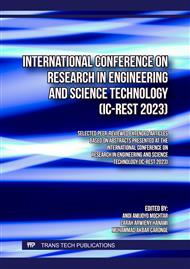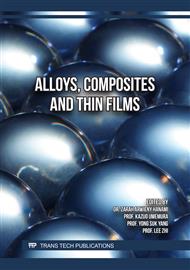p.3
p.15
p.25
p.41
p.49
p.57
p.71
p.83
Petung Bamboo (Dendrocalamus Asper) Woven Strip Composite: Effect of Immersion Time in Household Wastewater on Tensile Strength
Abstract:
Bamboo has become a raw material for products such as furniture, wickerwork, carvings, household furnishings, musical instruments and construction. The aim of this research is to find out how much tensile strength Petung bamboo has after being soaked using 100% household waste water. To calculate the tensile strength of petung bamboo material, the research method is based on the ASTM D 638-02 type 1 testing standard. Petung bamboo from Tana Toraja district, South Sulawesi province, Indonesia is the material used. The petung bamboo is cut into pieces and then woven with a plain-woven pattern (one by one) measuring 250 mm x 250 mm. This woven material is then made into woven pieces of petung bamboo (Dendrocalamus Asper). This research was carried out on a laboratory scale where woven petung bamboo was soaked in a box with varying immersion times, namely 0 week (without immersion), 2 weeks, 4 weeks, 6 weeks and 8 weeks. After immersion according to varying immersion times, proceed with making composite panels, namely combining woven pieces of petung bamboo with epoxy resin. Composite panels are made with 3 layers variations, namely 1 layer, 2 layers and 3 layers. The results showed that the maximum tensile strength The maximum tensile strength occurred at a Immersion time of 2 weeks with variations in household waste water content of 100% in the 2-layer composite of 65.54 ± 8.24 MPa and the 3-layer composite of 70.32 ± 11.42 MPa. Meanwhile, for 1-layer composites, household waste water content of 90% was 51.02 ± 6.13 MPa. The minimum tensile strength occurs at a Immersion time of 8 weeks of 22.29 ± 5.04 MPa for 1-layer composite with a household waste water content of 90%, and for 2-layer and 3-layer composites it is obtained at 100% household waste water content of 26.65 ± 12.63. MPa for the 2-layer composite while for the 3-layer composite is 32.06 ± 3.65 MPa. It can be said that at the beginning of immersion, the tensile strength value increases and then gradually decreases.
Info:
Periodical:
Pages:
41-47
Citation:
Online since:
March 2025
Authors:
Keywords:
Price:
Сopyright:
© 2025 Trans Tech Publications Ltd. All Rights Reserved
Share:
Citation:



